Knowing if your business needs a website is more important than ever. A professional site builds credibility and shows customers you’re legit, which can be a big deal when trust matters. It also helps boost your brand visibility and gives your products or services a clear online presence.
If you’re struggling with lead generation or losing visitors because your current site loads too slow, isn’t mobile-friendly, or feels outdated, it’s time for an upgrade. Besides working 24/7 like a sales channel, websites are cost-effective ways to reach new customers and support digital marketing efforts.

How a Website Builds Credibility and Trust for Your Business
A professionally designed website acts as a clear signal to potential customers that your business is legitimate and reliable, especially when they might otherwise hesitate. Including straightforward contact information along with client testimonials and genuine customer reviews helps build trust by showing real experiences.
Your website becomes the first impression that consistently reassures visitors about your professionalism and dependability. Showcasing certifications, awards, or partnerships adds another layer of credibility, demonstrating your commitment to quality and industry standards.
Keeping your content fresh and regularly updated indicates that your business is active and engaged with its audience, which further strengthens confidence. Secure features like SSL certificates protect visitors’ data, making users feel safer when interacting with your site.
A modern, clean design reflects attention to detail and professionalism, which customers notice. Transparency also plays a big role: clear policies on returns, privacy, and terms help visitors feel comfortable and informed.

Additionally, case studies or portfolio sections showcase your expertise and past successes, helping to convince visitors that you can deliver on your promises. Incorporating social proof tools, such as real-time notifications of customer activity, can also enhance trust by showing that others are engaging with your business right now.
Together, these elements make your website a powerful tool for establishing credibility and fostering lasting trust.
- A professionally designed website signals legitimacy to potential customers who might otherwise doubt your business.
- Clear contact information, client testimonials, and real customer reviews on your site enhance trustworthiness.
- A website acts as a consistent first impression that reassures visitors about your reliability.
- Displaying certifications, awards, or partnerships on your website further supports credibility.
- Regularly updated content shows that your business is active and engaged with its audience.
- Secure website features, such as SSL certificates, protect user data and build confidence.
- A modern and clean design reflects professionalism and attention to detail.
- Transparency through clear policies like returns and privacy builds trust with visitors.
- Case studies and portfolio sections demonstrate past successes and expertise.
- Integration of social proof tools, such as real-time notifications of customer activity, strengthens trust.
Ways a Website Boosts Your Brand and Visibility
A website is often the first place people interact with your brand, making it a powerful tool for communicating your identity through visuals like logos, colors, and the overall tone of your content. It provides a consistent platform to share your story, mission, and values, which helps customers connect with your business on a deeper level.
By optimizing your site for search engines, your business can appear in relevant search results, increasing exposure to potential customers who might not have found you otherwise. Adding engaging content such as blogs, videos, and infographics keeps visitors interested and spreads awareness about what you offer.
You can quickly highlight new products, promotions, or important updates, keeping your audience informed and engaged. With mobile responsiveness, your brand reaches users on any device, which is crucial since most web traffic comes from smartphones and tablets.
Local SEO features help draw customers nearby, making your business more visible in your area. Connecting your website to social media channels extends your reach even further, driving traffic back to your site and encouraging interaction across platforms.
A well-organized website encourages visitors to spend more time exploring your offerings, which strengthens their understanding and trust in your brand. Consistent messaging across your website and marketing efforts reinforces brand recognition, making your business stay top of mind when customers need your products or services.
How Websites Help Generate More Leads
A well-designed website plays a crucial role in generating leads by attracting visitors who are already interested in your services. By optimizing your site for search engines (SEO), you increase the chances of appearing in organic search results, bringing in potential customers actively looking for what you offer.
Clear calls-to-action (CTAs) throughout the site help guide visitors toward taking specific steps like making inquiries, subscribing to newsletters, or making purchases. Features such as contact forms and live chat provide easy, direct ways for prospects to reach out, removing barriers to communication.
Additionally, landing pages tailored to specific marketing campaigns can capture highly targeted leads effectively. Offering downloadable resources like ebooks or guides in exchange for contact information helps grow your email list, giving you a valuable channel for nurturing prospects.
Including testimonials and case studies builds trust by showing real customer success stories, which encourages visitors to engage further. Regularly updating your content keeps visitors coming back and increases the likelihood of conversion over time.
Behind the scenes, integrating analytics tools lets you track visitor behavior and optimize your lead generation strategies based on real data. Automated follow-up tools connected to your website ensure that leads are nurtured consistently without manual effort.
Finally, a fast-loading, user-friendly website keeps visitors engaged longer and reduces bounce rates, maximizing your chances to convert them into customers.
Why Your Website Should Work 24/7 for Sales and Support
A website that operates around the clock gives your business a clear advantage over physical stores limited by business hours. Customers can browse products, read service details, or make purchases whenever it suits them, whether late at night or early morning.
This flexibility means you capture sales and interest from spontaneous visitors who might not wait for regular hours. Self-service features like FAQs, chatbots, or troubleshooting guides empower users to find answers instantly, reducing the need for repetitive support calls and freeing your team to focus on more complex tasks.
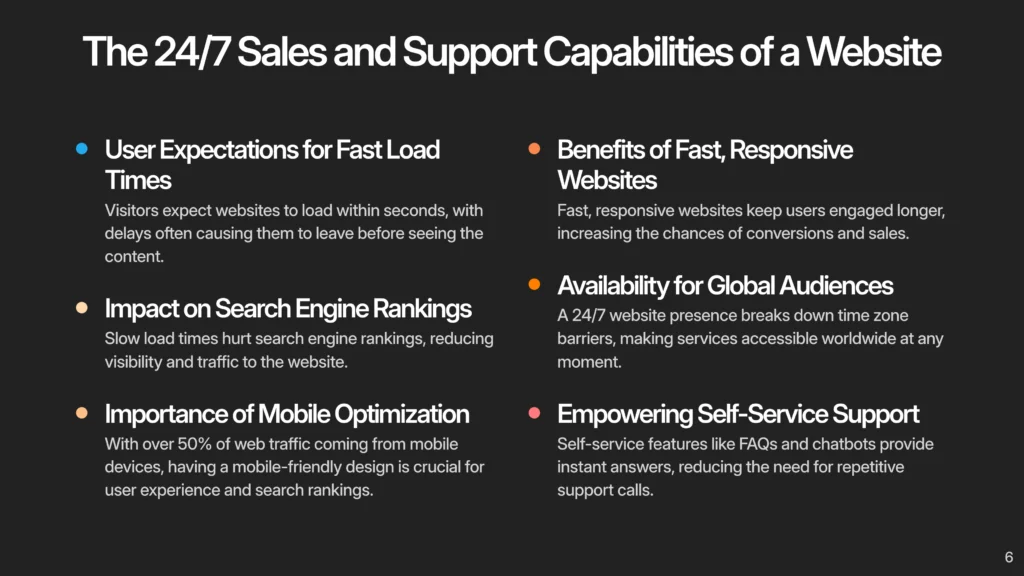
Automated inquiry forms and responses ensure no question goes unanswered, improving customer satisfaction. For businesses with a global audience, a 24/7 website presence breaks down time zone barriers, making your services accessible worldwide at any moment.
Additionally, continuous availability allows you to track user behavior and preferences at all times, providing valuable insights that can refine your sales and support strategies. In this way, your website becomes a reliable, always-on sales and support channel that enhances customer experience and boosts business growth.
How a Website Saves Costs and Supports Business Growth
A website can significantly lower your business expenses compared to maintaining physical locations or hiring additional staff. Instead of paying rent or wages for multiple storefronts, your website serves as a central hub where customers can learn about your products, place orders, and get support any time of day.
This digital presence also cuts down on labor costs by automating routine tasks like answering common questions or processing sales. Beyond cost savings, a website expands your reach far beyond your local area, letting you connect with customers nationwide or even globally without the extra overhead.
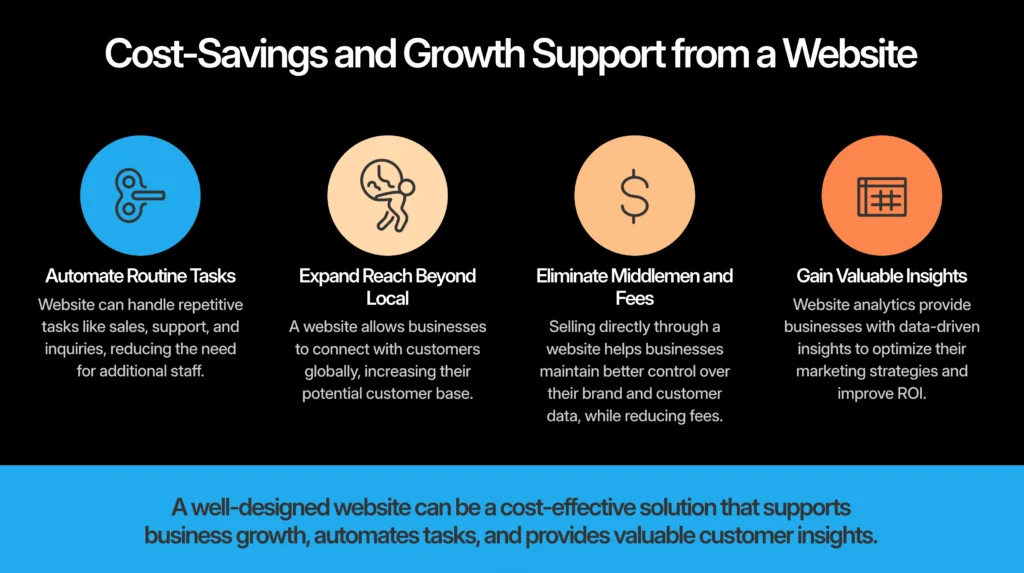
You can easily add new products or services online as your business grows, making scaling more manageable and cost-efficient. By selling directly through your site, you eliminate middlemen, which reduces fees and gives you better control over your brand and customer data.
Plus, the insights you gain from website analytics help you focus your marketing budget on strategies that actually work, improving your return on investment. Even small businesses can compete more effectively with larger companies thanks to the accessibility and flexibility a website offers.
Regular updates and digital tools embedded on your site keep operations running smoothly without major expenses, supporting steady growth while keeping costs in check.
Why Your Website is Key to Digital Marketing Success
Your website acts as the central hub where all your digital marketing efforts come together. Whether you’re running pay-per-click ads, sending email campaigns, or creating content, every channel directs traffic back to your site.
This makes having optimized landing pages essential, as they improve conversion rates and allow you to track the effectiveness of each campaign clearly. SEO plays a vital role by helping your website rank for the right keywords, drawing in visitors who are already interested in what you offer.
Email marketing depends on your website for sign-ups and delivering valuable content that nurtures leads over time. Well-designed, relevant pages boost the performance of your ads by providing visitors a seamless experience, increasing the chances they’ll take action.
Content marketing further supports your site by building authority and driving consistent traffic through blog posts and resources. Your website also provides analytics that measure campaign success, guiding smarter budget decisions.
Adding social proof elements like testimonials and reviews on your site enhances credibility, encouraging visitors to trust your brand and boosting campaign results. With mobile-friendly design, your campaigns reach users smoothly on any device, which is critical given the high volume of mobile traffic today.
Lastly, integrating your website with marketing automation tools allows you to personalize customer journeys, delivering tailored messages that convert better. In short, your website is not just a digital presence but the backbone of a successful marketing strategy.
Using Website Data to Understand Your Customers Better
Website data offers valuable insights that help businesses truly understand their customers. Analytics tools track detailed visitor demographics, interests, and behaviors, revealing who your audience is and how they interact with your site.
For example, heatmaps highlight the most viewed sections, showing what catches attention and what might need improvement. By analyzing conversion funnels, you can identify exactly where visitors lose interest and drop off, allowing you to fix those points and improve sales or sign-ups.
Customer feedback forms add another layer by gathering direct, qualitative input on their experience, which numbers alone can’t provide. Tracking which products and pages are popular helps you tailor your offerings to match real customer preferences.
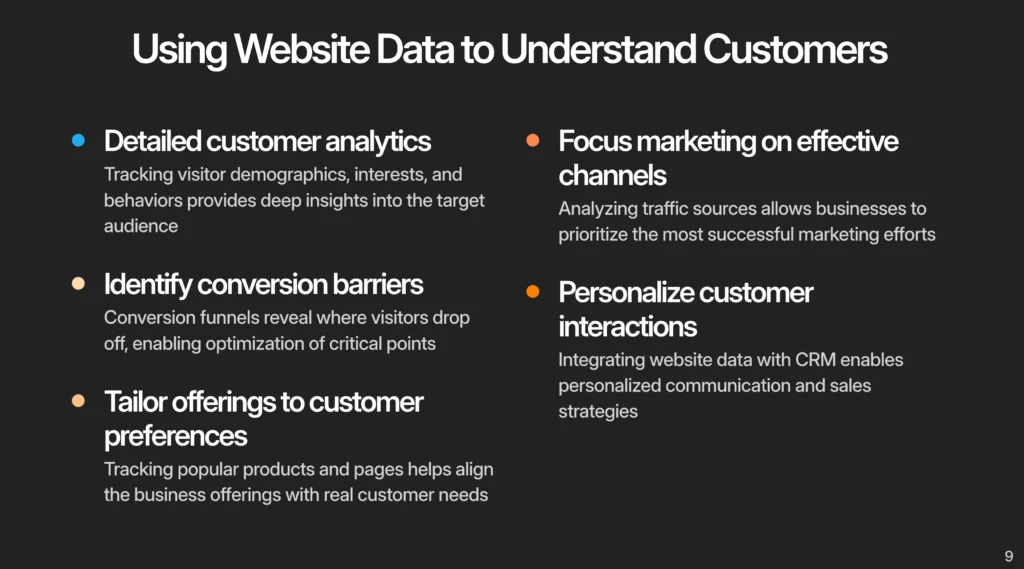
Meanwhile, knowing where your visitors come from, whether search engines, social media, or ads, lets you focus your marketing efforts on the channels that bring the best traffic. Engagement metrics like repeat visits and session length indicate loyalty and satisfaction, guiding you to keep users coming back.
A/B testing different website designs or content also helps pinpoint what works best for your audience. When you integrate your CRM with website data, you can personalize communication and sales strategies based on actual user behavior.

Real-time monitoring further enables quick adjustments to meet changing customer needs. All of these data points combined make your website a powerful tool not just for sales but for building deeper connections with your customers.
How a Website Gives You a Competitive Edge
A modern, well-functioning website sets your business apart from competitors who have outdated sites or none at all. When your site loads quickly and works smoothly on mobile devices, visitors are more likely to stay and explore, while slower, less optimized sites lose potential customers.
SEO strategies help your business appear higher in search results, putting you ahead of rivals who lack this visibility. Offering online sales or booking options adds convenience that many competitors may not provide, making it easier for customers to choose you.
Publishing valuable content positions your business as an expert in your field, strengthening your authority where others fall short. Displaying testimonials and reviews builds trust more quickly than competitors who don’t showcase social proof.
Using data insights from your website lets you respond swiftly to market changes, giving you an advantage over businesses that rely on guesswork. A flexible website platform allows you to launch new features or marketing campaigns faster, keeping your offerings fresh and relevant.
Social proof notifications highlight real-time customer activity, signaling popularity and encouraging new visitors to engage. Integrating online customer support tools improves satisfaction and responsiveness beyond what competitors may offer, making your business the preferred choice.
Signs Your Website Needs an Update or a Refresh
If your website pages load slowly, visitors get frustrated and often leave before engaging, which hurts your bounce rates and search rankings. Another clear sign is if your site isn’t mobile responsive, since more than half of web traffic comes from mobile devices, losing these users means missing out on a large audience.
High bounce rates also suggest that users aren’t finding what they need or that your content isn’t relevant, so they leave quickly. Confusing navigation or broken links can block visitors from finding important information, leading to poor user experience and lost opportunities.
Outdated content that doesn’t reflect your current products, services, or branding can confuse customers and damage your reputation. Security is another concern; if your site lacks basic protections like SSL certificates, you risk losing customer trust.
If you find it difficult to update your site or add new content, it limits your ability to respond quickly to market changes and marketing campaigns. An old-fashioned design compared to competitors’ sites can make your business appear behind the times, affecting how potential customers perceive you.
Finally, if your website isn’t generating leads or converting visitors despite your marketing efforts, or if technological incompatibilities prevent adding new features and integrations, it’s time for a refresh. Addressing these issues can improve user experience, boost engagement, and help your business stay competitive.
Why Fast Load Speed and Mobile Friendliness Matter
Visitors expect websites to load quickly, usually within a few seconds, and any delay often causes them to leave before seeing your content. This impatience affects more than just user experience, Google also ranks faster websites higher in search results, which means a slow site can hurt your visibility and reduce traffic.
Since mobile users now make up the majority of web traffic, having a mobile-friendly design is crucial. Poor mobile usability drives visitors away and lowers your search rankings.
Fast, responsive websites keep users engaged longer, increasing the chances they’ll explore your offerings and complete a purchase. On the other hand, slow-loading sites lead to lost sales and fewer conversions.
Optimizing images and code helps improve load speed without sacrificing quality, ensuring your site looks good and performs well. A smooth mobile experience also supports consistent branding and functionality across devices, encouraging repeat visits and building customer loyalty.
Overall, a fast, accessible, and mobile-friendly website reduces bounce rates, improves SEO performance, and boosts customer satisfaction and trust.
How Poor User Experience Drives Visitors Away
Slow page load times frustrate visitors and often push them to leave before they even see your content. When navigation is complicated, users struggle to find what they need quickly, which increases the chance they’ll abandon the site.
An outdated design can make your business seem neglected and untrustworthy, causing potential customers to doubt your credibility. Broken links or missing images interrupt the user journey, making the site feel unprofessional and unreliable.
With more people browsing on phones and tablets, a lack of mobile responsiveness can alienate a large portion of your audience, leading to lost opportunities. Cluttered or confusing layouts overwhelm visitors, making it hard for them to focus on important information and driving them away early.
If your website doesn’t consider accessibility, you risk excluding users with disabilities, shrinking your audience and engagement. Without a clear call-to-action, visitors may leave unsure about what to do next, lowering your chances to convert interest into sales.
Pop-ups and intrusive ads that disrupt the browsing experience increase annoyance and bounce rates. Finally, poor functionality, like error pages or slow-loading forms, can frustrate visitors and deter them from becoming customers.
These issues combine to create a user experience that pushes visitors away rather than inviting them in.
When Outdated Content and Design Hurt Your Business
Having outdated content on your website can confuse visitors by misrepresenting what your business currently offers. If your products, services, or business direction aren’t accurately reflected, potential customers might leave without understanding your true value.
Design trends evolve quickly, and an old-fashioned look can make your brand appear behind the times or out of touch. Search engines also favor fresh, relevant content, so stale pages can lower your SEO rankings and reduce organic traffic.
When your branding is inconsistent across outdated pages, it weakens recognition and trust, making it harder to build lasting customer relationships. Customers expect websites to reflect activity; old blogs or news sections suggest inactivity and may hurt your reputation.
Additionally, older designs often lack modern features like responsive layouts, which make browsing on mobile devices smooth, or interactive elements that engage users. Security risks increase if outdated plugins or themes aren’t updated, leaving your site vulnerable.
Meanwhile, competitors with sleek, updated websites attract the customers you might lose due to an outdated online presence. Missed chances to showcase new promotions or products mean lost sales opportunities and potential misinformation that can damage customer trust.
Keeping your website current is essential to maintaining credibility, improving user experience, and staying competitive in today’s digital market.
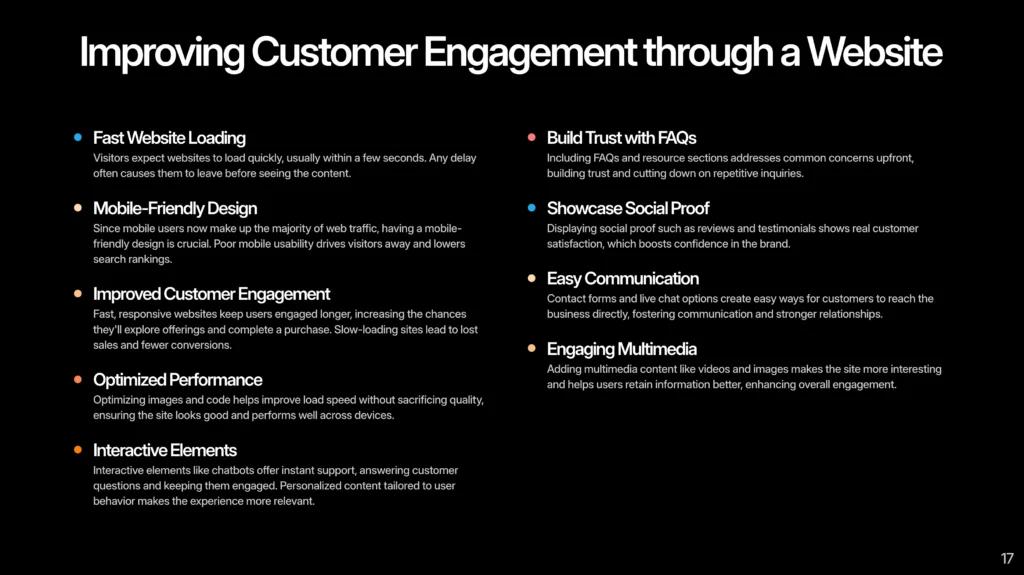
The Need for Modern Technology and Easy Updates
Modern technology has made managing a website much simpler and more effective for businesses of all sizes. Content management systems (CMS) like WordPress, Wix, or Shopify enable quick updates without needing any coding skills, so you can easily keep your products, services, or company info current.
Mobile-first design ensures your site looks and works well on smartphones, tablets, and desktops, providing a smooth experience no matter the device. Integrating analytics tools helps you understand visitor behavior, allowing you to make informed improvements to your site’s performance.
Security is also a key factor; modern platforms come with built-in features to protect your site from hacking and data breaches, safeguarding your business and customer information. Flexible design frameworks mean you can implement new features or change layouts faster, keeping your site fresh and relevant.
Automation tools linked to your website can simplify marketing tasks like email campaigns or social media posting, saving time and increasing efficiency. SEO-friendly technology enhances your search engine rankings, driving more organic traffic to your site.

Compatibility with the latest browsers guarantees that all visitors enjoy a consistent experience without glitches. Lastly, cloud hosting and content delivery networks (CDNs) improve your website’s loading speed and uptime reliability, ensuring customers can access your site anytime without frustration.
Embracing these modern tools and capabilities makes your website a dynamic, secure, and effective asset that supports your business growth effortlessly.
How to Spot Low Lead Generation on Your Website
One clear sign of low lead generation is having a lot of visitors but very few contact form submissions or inquiries. If people are coming to your site but aren’t reaching out, something is off.
Similarly, if your newsletter sign-ups are scarce or nonexistent, it shows weak audience engagement and missed opportunities to build relationships. High bounce rates also point to problems, as visitors leave quickly without interacting, often due to unclear messaging or poor site layout.
Pay attention to how often visitors click on call-to-action buttons or promotional offers; minimal click-throughs suggest your prompts aren’t compelling or easy to find. A common issue is missing or hard-to-find contact information and lead capture elements, which frustrates visitors who want to connect but can’t.

If you don’t offer lead magnets like free downloads, trials, or discounts, you might be missing a chance to entice visitors to share their info. Beyond the website itself, having no follow-up systems such as automated emails or remarketing campaigns means leads slip through the cracks.
Also, without integration with CRM tools, tracking and nurturing potential customers becomes difficult. Check where your traffic is coming from, if those sources aren’t converting, your ads or content might not match visitor expectations.
Lastly, the absence of social proof, like testimonials or reviews, can reduce trust and stop visitors from engaging further. Addressing these signs can help you fix lead generation issues and turn your website into a more effective business tool.
Benefits of SEO and Increased Organic Traffic
Having a website optimized for SEO helps your business show up higher in search engine results, bringing in more qualified visitors who are already interested in what you offer. Unlike paid ads, organic traffic generated through SEO is cost-efficient and builds over time, giving you steady visitors without ongoing advertising expenses.
Optimized content that matches customer intent improves the chances that visitors will take action, whether that means making a purchase or contacting you for more information. Local SEO is especially valuable for attracting nearby customers searching for relevant services, helping drive foot traffic or inquiries.
SEO also provides insights into customer preferences and popular search terms, allowing you to tailor your offerings and content effectively. A well-structured site with clear metadata not only improves search engine crawlability but also enhances user experience, making it easier for visitors to find what they need.
Regular content updates keep your website fresh and competitive, signaling to search engines that your business is active. Building a strong backlink profile from reputable sites further boosts your website’s authority and ranking.
Over time, these SEO efforts compound, creating long-term traffic growth that supports business stability and expansion.
Ways a Website Improves Customer Engagement
A website with interactive elements like chatbots offers instant support, answering customer questions right away and keeping them engaged. Easy navigation helps visitors find products or information quickly, reducing frustration and encouraging exploration.
Personalized content tailored to user behavior makes the experience more relevant, increasing the chance customers will return. Including FAQs and resource sections addresses common concerns upfront, building trust and cutting down on repetitive inquiries.
Regular blog posts or updates provide fresh information, giving visitors a reason to come back and stay connected. Displaying social proof such as reviews and testimonials shows real customer satisfaction, which boosts confidence in your brand.
Contact forms and live chat options create easy ways for customers to reach you directly, fostering communication and stronger relationships. A user-friendly design keeps visitors on your site longer and encourages them to explore more pages.
Clear call-to-action buttons guide users smoothly toward next steps like making a purchase or signing up for newsletters. Adding multimedia content like videos and images makes your site more interesting and helps users retain information better, enhancing overall engagement.
Why Local Businesses Need a Strong Online Presence
Most customers start their search online before visiting or contacting a local business, making a strong online presence essential. Local SEO helps your business appear in map results and local search queries, putting you in front of nearby customers actively looking for your products or services.
A website lets you share important details like store hours, location, and contact info clearly, reducing confusion and missed opportunities. Customer reviews and testimonials displayed on your site and directories build trust within the community, giving potential clients confidence to choose you over competitors.
You can also promote special offers, events, and new products directly to your local audience, increasing engagement and foot traffic. Having a website makes it easier to form partnerships and collaborations with other local businesses, strengthening your network.
Since many people search on mobile devices while on the go, a mobile-friendly design ensures your business is accessible anytime, anywhere. Features like online booking or ordering add convenience for customers and help boost sales.
Without a website, local competitors with online visibility will have an advantage in capturing market share. In today’s digital age, a strong online presence is no longer optional for local businesses but a key driver of growth and customer loyalty.
How a Website Attracts Partners and Talent
A website plays a key role in drawing the right partners and talent by offering a clear window into your company’s culture and values. When potential collaborators visit your site, detailed descriptions of your services and projects help them quickly understand if your businesses align.
Career pages that outline job openings and the application process make it easier for candidates to take the next step. Including testimonials and case studies builds credibility, showing professional contacts that you deliver results and maintain strong relationships.
Regular blog posts and news updates highlight your industry knowledge and leadership, which appeals to ambitious professionals and partners wanting to work with experts. Multimedia content like videos provides a more dynamic, authentic look at your workplace, making your company feel more approachable and real.
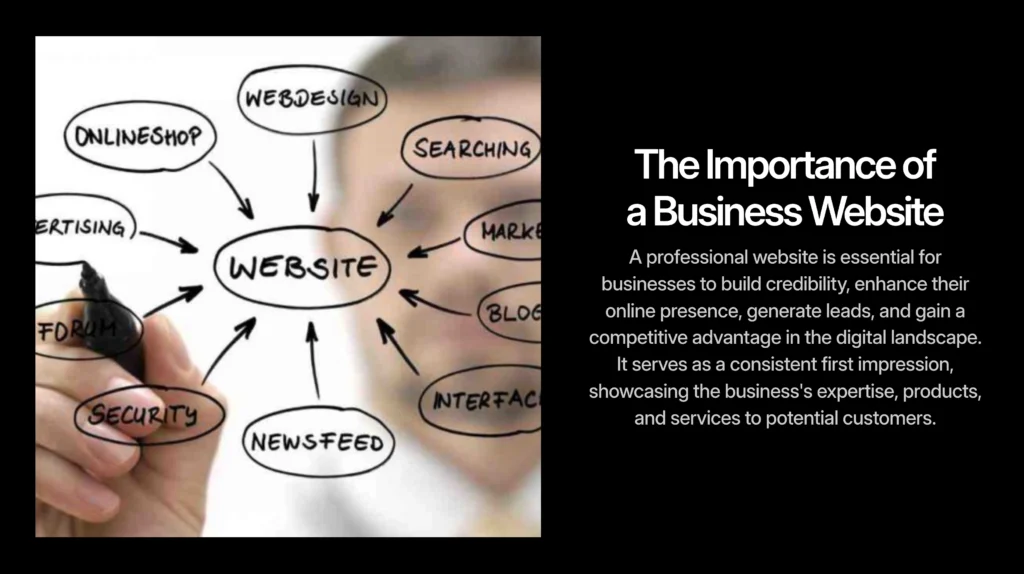
Easy-to-find contact options simplify reaching out for networking or partnership inquiries. Additionally, emphasizing employee benefits and career growth opportunities helps attract top talent looking for long-term development.
Search engine optimization (SEO) ensures your website appears in searches by recruiters and business partners, increasing your chances of being discovered. Keeping your website regularly updated signals an active, growing business, which is always more appealing to motivated partners and skilled professionals.
Using Your Website to Test Products and Upsell
Your website can be a powerful tool for testing new products and boosting sales through upselling. By creating dedicated landing pages, you can introduce new offerings and measure visitor interest without a big upfront investment.
Running A/B tests on product pages helps identify which layouts, descriptions, or offers resonate best with your audience. Bundling related products or services encourages customers to spend more, increasing your average order value.
Collecting feedback through surveys or reviews lets you refine your products based on real customer input. Limited-time promotions showcased on your site can create urgency, prompting quicker buying decisions.
Tracking visitor behavior reveals popular items and natural upsell opportunities, which you can enhance with personalized recommendations tailored to browsing or purchase history. Offering free trials or samples reduces hesitation and builds trust, while retargeting ads linked to website visits keep your products top of mind.
Finally, analyzing sales data from online transactions helps you plan inventory and marketing efforts more effectively, making your website an essential platform for testing, selling, and growing your business.
How Direct Customer Connections Boost Your Business
Having a website allows your business to connect directly with customers, cutting out intermediaries and reducing costs. This direct line means you control your messaging and branding, ensuring a consistent experience.
By collecting customer data from website interactions, you gain valuable insights that help tailor marketing efforts and improve your products or services. Quick response times through direct channels boost customer satisfaction, encouraging loyalty and repeat business.
Personalized communication makes customers feel valued, strengthening relationships and turning buyers into advocates who spread positive word of mouth. Direct feedback from your site helps spot issues early, allowing for faster problem resolution.
Additionally, social proof from real customer interactions builds trust and credibility, making new visitors more comfortable engaging with your brand. Tools like newsletters and online forums foster a community around your business, increasing engagement and keeping your audience connected.

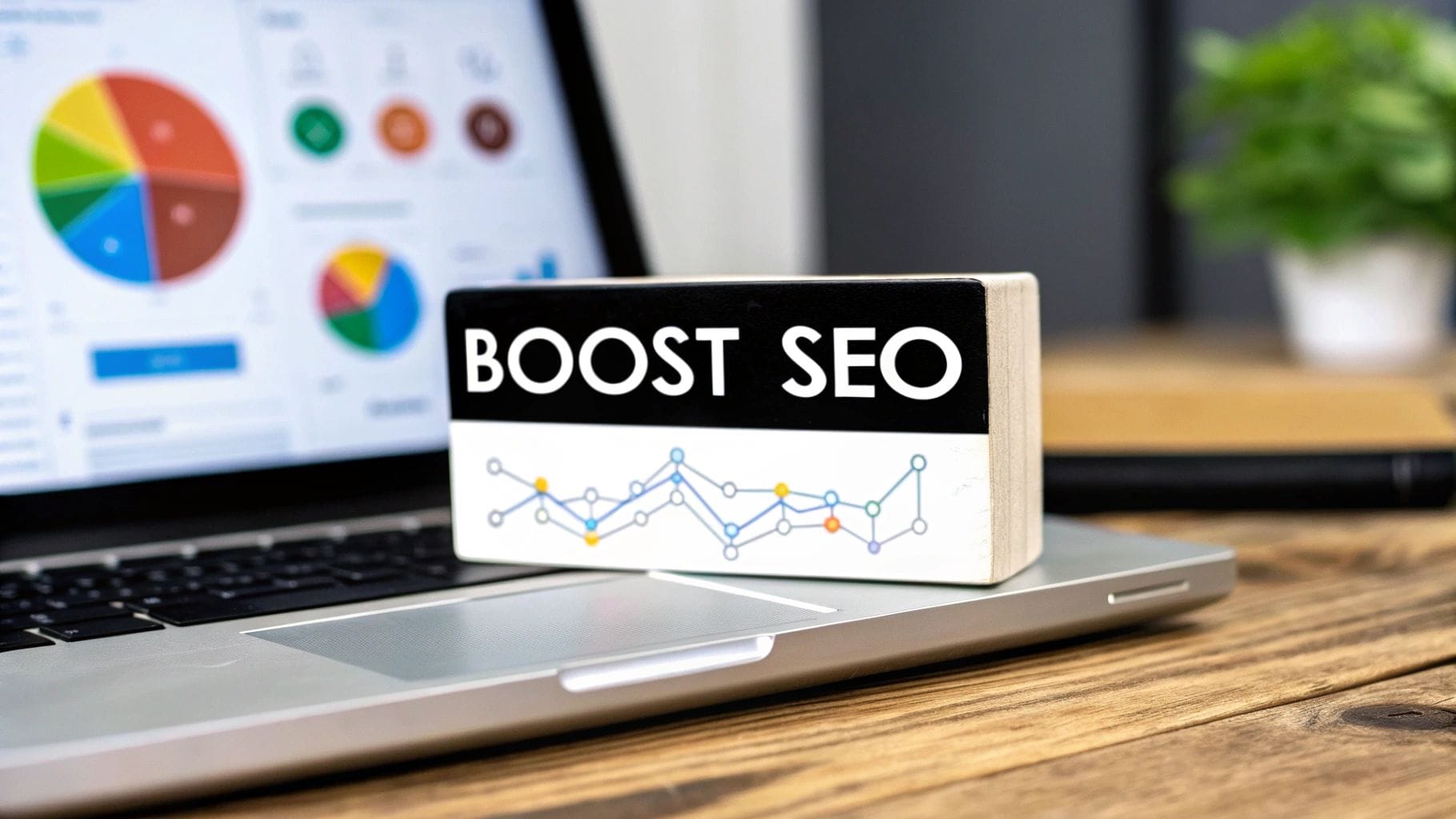


Leave a Reply